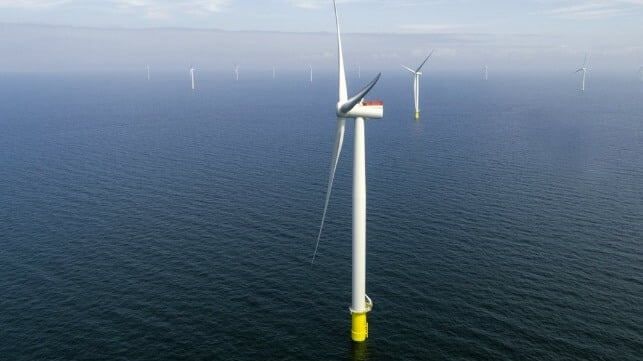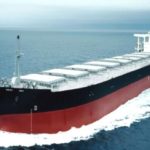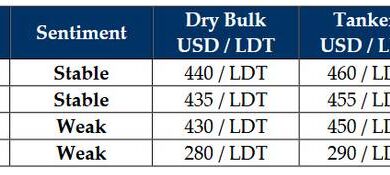Mitigating Deadly Maritime Risk: Inside AWO’S Falls
Falls overboard remain the leading cause of fatalities in the U.S. tugboat, towboat, and barge industry, a sobering reality that the American Waterways Operators (AWO) has been working to reverse for decades. Now, with the release of its comprehensive Falls Overboard Prevention Report, AWO and its partner are charting a data-driven path to help reduce this risk.
The report, produced under the Coast Guard–AWO Safety Partnership, builds on decades of collaboration between regulators and industry leaders, a partnership that has yielded meaningful results: from 2004–2013, the industry averaged 9.5 crew fatalities annually, a figure reduced to 5.4 per year between 2014–2023, according to AWO’s annual safety reports.
Still, falls overboard remain the single most common cause of fatalities, demanding a sharper focus on prevention. In May 2022, AWO reorganized its Permanent Subcommittee on Crew Fatalities as the Falls Overboard Subcommittee to intensify work on this issue.
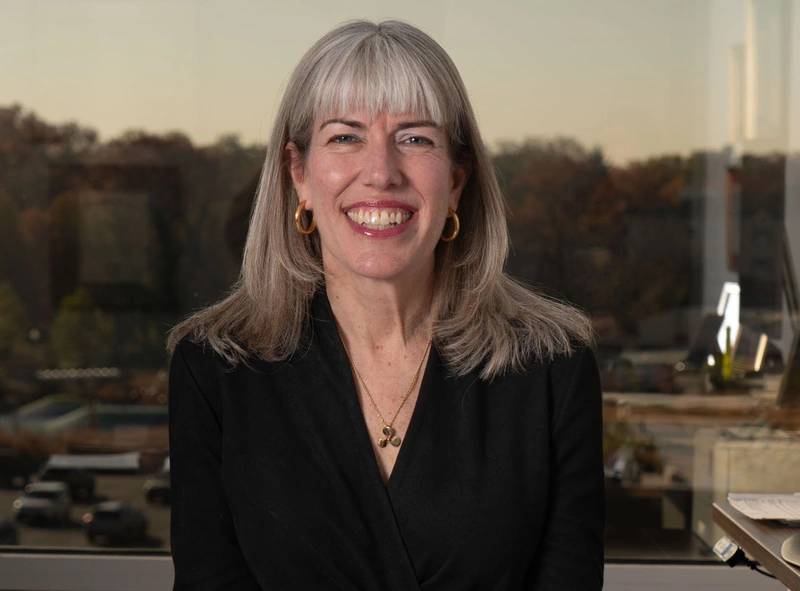 “The tugboat, towboat and barge industry is proud to be the safest mode of freight transportation in the United States, thanks to our industry’s strong commitment to continuous improvement in safety. We commit ourselves every day to doing better. AWO is sharing our Falls Overboard Prevention Report to help companies across America keep mariners safe while moving our nation’s vital maritime commerce, and we encourage companies throughout the industry to join us on August 28 in raising awareness of this critical safety priority.” — Jennifer Carpenter, President & CEO, AWO
“The tugboat, towboat and barge industry is proud to be the safest mode of freight transportation in the United States, thanks to our industry’s strong commitment to continuous improvement in safety. We commit ourselves every day to doing better. AWO is sharing our Falls Overboard Prevention Report to help companies across America keep mariners safe while moving our nation’s vital maritime commerce, and we encourage companies throughout the industry to join us on August 28 in raising awareness of this critical safety priority.” — Jennifer Carpenter, President & CEO, AWO
Understanding the Problem
To ground its recommendations in real-world data, AWO surveyed its members on fall-overboard incidents spanning 2012–2024, analyzing 118 incidents in total. The findings are stark:
- 68% of incidents occurred on barges, underscoring the heightened risk on unguarded, low-freeboard vessels.
- 66% of falls took place at night (between 9:00 p.m. and 7:00 a.m.), pointing to the added dangers of reduced visibility and fatigue.
- 52% of incidents involved deckhands, followed by tankermen (28%).
Experience did not guarantee safety—45% of incidents involved mariners with two or more years of experience, while 55% involved those with one year or less.
Slip, trip, and fall hazards were the primary causal factor in 84% of incidents, followed by distraction or lack of situational awareness (26%).
“Experience alone doesn’t inoculate mariners from risk,” the report emphasizes. “Addressing systemic hazards and human factors is critical.”
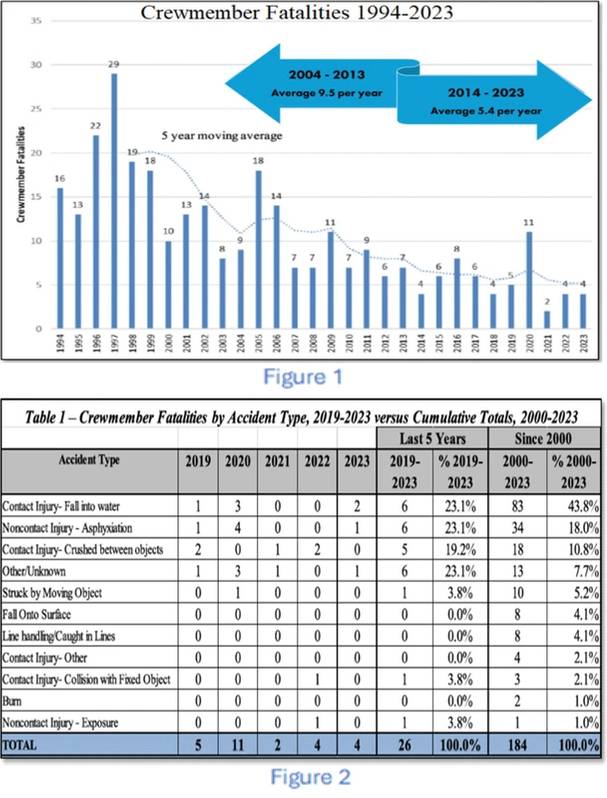 Source: AWO Falls Overboard Prevention Report
Source: AWO Falls Overboard Prevention Report
A Multi-Layered Approach
The report organizes its recommendations using a modified Hierarchy of Controls—from eliminating hazards altogether to employing personal protective equipment (PPE).
- Elimination and Substitution:
- Using interior gunnels for transit instead of unguarded perimeters.
- Employing hands-free mooring systems to reduce crew exposure during locking operations.
- Remote drafting devices and cranes/davits for cargo hose handling.
- Engineering Controls:
- Installing guardrails, restraint systems, and scaffold boards with guardrails for safer access.
- Design Mitigations:
- Non-slip deck coatings, handholds, visual edge alerts, and strategic placement of deck appliances to minimize trip hazards.
- Administrative Controls:
- Improved housekeeping protocols and de-icing procedures.
- Training programs on situational awareness, fatigue management, and substance-use risks.
- PPE:
- Expanding use of fall restraint systems and horizontal lifelines, with detailed guidance on their safe application.
Looking to the future, the report encourages incorporating safety into new barge design. Recommendations include wider walkways, relocated inboard working areas, raised coaming walls, and even remote monitoring systems to minimize the need for crew to approach unguarded edges.
The stakes couldn’t be higher. The AWO represents nearly 5,000 tugboats and towboats and 33,000 barges—a fleet moving 665 million tons of cargo annually over 25,000 miles of inland and coastal waterways. These vessels form the backbone of U.S. commerce, carrying more than 60% of export grain and other critical bulk commodities. Protecting the mariners who operate them is not only a moral imperative but also essential to sustaining this vital industry.
The report stresses that no single intervention can solve the fall-overboard problem. Instead, a layered strategy combining engineering, training, and cultural change is essential. As AWO’s Subcommittee put it: “Preventing falls overboard means building safety into every aspect of vessel design, operation, and behavior.”
- Alongside releasing the report, AWO is also organizing Falls Overboard Safety Standdown Day, which will take place on August 28, 2025. AWO is encouraging tugboat, towboat and barge companies to pause briefly on August 28 to discuss falls overboard prevention with vessel crews, and to promote falls overboard prevention by sharing their company’s participation on social media, using the hashtags #StopFallsOverboard and #AWOSafety. AWO’s guide to participating in Falls Overboard Safety Standdown Day includes sample discussion prompts for conversations with crews, suggested follow-up actions, social media post examples, and other information.
The AWO Falls Overboard Prevention Report is available here.
